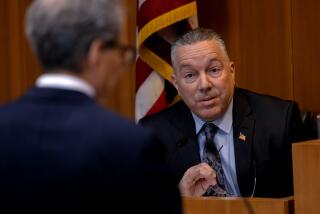Simpson Detective Deviated From Usual Practice, Expert Testifies
- Share via
Los Angeles Police Det. Philip L. Vannatter, denounced as a “devil of deception” by O.J. Simpson’s defense team, deviated from standard procedure when he came to the coroner’s office to pick up blood samples from murder victims Nicole Brown Simpson and Ronald Goldman, a supervising criminalist has testified.
While other evidence collected from the bodies was sent directly to the LAPD’s scientific lab, Vannatter took charge of the victims’ blood samples, criminalist Gary L. Siglar said during a deposition.
The samples were used to compare the victims’ genetic makeup with blood splotches on pieces of evidence, including the socks discovered in O.J. Simpson’s bedroom and the gloves found on his estate and at the crime scene.
Siglar, a supervising criminalist in the coroner’s office, testified May 21 about handing the blood samples to Vannatter. Although Simpson was acquitted on murder charges in criminal court, the victims’ families are pressing a wrongful death lawsuit against him in civil court. Lawyers have been gathering depositions for months.
“Is it true that except for the typing blood samples from both Goldman and [Nicole] Brown, every other item of evidence that was turned over to the LAPD was turned over to the [Scientific Investigation Division]?” Simpson lawyer Daniel P. Leonard asked Siglar, according to a transcript reviewed by The Times on Thursday.
Siglar said “yes.” Later, asked how often he had seen blood samples handed directly to a detective, Siglar responded: “I’ve seen it occur a few times over the 12 years I’ve been with the coroner’s office.”
The exchange took just a minute or two of a lengthy deposition, but it touched on a theme that O.J. Simpson’s criminal defense attorneys raised often in winning his acquittal during the murder trial.
The defense repeatedly denounced Vannatter, a veteran homicide investigator, for driving across town with a vial of O.J. Simpson’s blood before delivering it to a criminalist. During the three hours that Vannatter had the vial, the defense suggested, conspirators bent on framing Simpson could have sprinkled drops of the blood on key bits of evidence.
The last volume of Siglar’s deposition testimony, in which the plaintiff’s attorneys had an opportunity to question him, was not available.
Siglar’s testimony could raise suspicion about Vannatter’s handling of the victims’ blood as well.
While the defense might seize on Siglar’s testimony as bolstering its conspiracy theory, Police Capt. Will Gartland defended Vannatter’s actions. Gartland, the commanding officer in the robbery-homicide division, said in an interview that Vannatter had two good reasons for picking up the blood samples June 15: to save time and to keep close tabs on the vials.
Detectives wanted to run lab tests immediately to sort out all the blood at the murder scene and separate the victims’ blood from the suspect’s, Gartland said. Sending the blood through normal channels--by an LAPD messenger making regular rounds--would have delayed the critical tests.
In other deposition testimony reviewed Thursday, Kansas City Chiefs football player Marcus Allen said O.J. Simpson called him from jail during the criminal trial asking him to testify that he had carried on an affair with Nicole Simpson--even though he had not.
Allen said he refused to testify because “it wasn’t true. The relationship didn’t happen.”
Also Thursday, defense lawyers won a court order to postpone the deposition of a New York photographer who claims to have snapped a photo of Simpson wearing Bruno Magli shoes.
If valid, the photo could be devastating to the defense because Simpson has insisted he never owned a pair of Bruno Maglis--the rare, expensive brand linked to the bloody footprints at the murder scene. Defense lawyers suspect that the photo, printed in the National Enquirer, may have been doctored. A judge delayed the deposition to give them a chance to track down and study the negatives before confronting the photographer.
More to Read
Sign up for Essential California
The most important California stories and recommendations in your inbox every morning.
You may occasionally receive promotional content from the Los Angeles Times.













